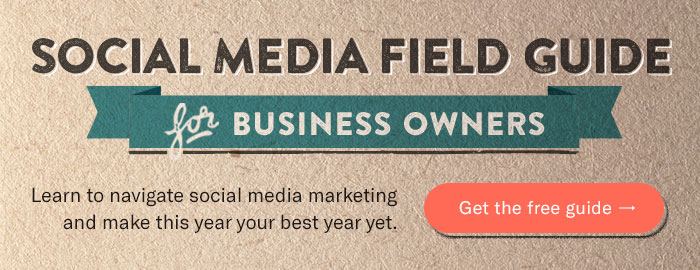Yesterday, we hosted a webinar on how to grow your social networks, covering the big three sites: Facebook, Twitter, and LinkedIn. We had an incredible turnout and a lot of great questions. More importantly, we were able to send everyone away with some powerful information they can immediately put to use in their own businesses. Due to this successful turnout, I felt compelled to share this info with everyone, not only people who attended our webinar.
If you’d like to watch a recording of the webinar, you can find the link to it below. You can access the slide deck from our SlideShare page here.
Here are the main points we covered.
The majority of the webinar focused on things that are, for the most part, hidden in plain sight. There isn’t a magic trick or tool you can use to gain overnight success. As it turns out, the best way to grow your social networks is by genuinely embracing them and interacting with people in a social way, using the various features that are provided.
1) The Difference Between Fans, Followers and Connections
Not all of your fans are created equal and understanding the relationship you’ll have with people on each network is the first step in efficiently growing your audience. On LinkedIn, your contacts are known as your connections. Think of LinkedIn as your online résumé but in social packaging. The connections you have on here can be anyone from past coworkers to current clients. This is the network to showcase your industry knowledge and professional expertise. With Twitter, the people connected to you are called your followers. They have subscribed to read what you post, and if you follow them back you’ll be able to see what they post as well. The biggest point here is that reciprocity isn’t required. You can have lots of followers without following many people back, and vice versa. And lastly, we covered Facebook. With Facebook, the people who have “Liked” your business page are know as your fans. Think of this both as a subscription to your posts as well as a form of public endorsement for your business. While you cannot initiate a conversation with your Facebook fans like you can with Twitter followers, you can prompt interactions by sharing content to your page.
2) Vanity Metrics
While it’s common to immediately think, “I’ve got to get more followers on social media to succeed,” that’s the exact logic we set out to combat. Sure, you can look at social as a numbers game if you want, but at the end of the day, big numbers with low engagement doesn’t really help your cause. Success on social media is a result of how engaged your audience is with you and what you post. In all honesty, I would rather have a Facebook page that had 100 fans and 20% engagement on every post, versus a page that had 10,000 fans and less than 1% engagement. The biggest takeaway from all this is that you should focus your network growth on getting the right audience rather than a bigger audience. Start with people you know and let your social presence become the online extension of your offline self. Micro touches across these networks help to keep you on people’s radars and help to continue the relationships you’ve built with them without having to physically be there.
3) How to Build a Robust Network on LinkedIn
The first network we tackled was LinkedIn and with good reason. While the “sexier” social networks like Facebook and Twitter get a lot more attention than LinkedIn, this is the network to focus on to keep your repeat business and referrals booming. The major advantage of LinkedIn is that it allows anyone to vet your professional clout and credibility while letting those close to you know that you’re still in business. The key areas we covered to build a robust LinkedIn network include:
-
- Completing your profile
- Connecting your address book(s)
- Revisiting your address book connections on occasion
- Exporting your contacts
- The best approaches to searching for new connections
- Personalizing your connection requests
- Becoming an open networker
- Recommendations and public endorsements
- Sharing industry relevant and compelling content
- Joining and participating in groups
- LinkedIn blogs and publishing
- Distributing your profile and content
When harnessed together, all of these actions result in a professional presence online that helps you stay in contact with past and present clients. It’s also an easy way for you to stay updated on what is happening in the professional lives of your contacts.
4) Turning Conversations into Followers on Twitter
Next, we discussed Twitter. While radically different and arguably more chaotic than LinkedIn or Facebook, Twitter has solidified its place as the network to be on for the latest and most up-to-date happenings in the world. It’s also different than the other two networks because of the public nature of everything that everyone does on it, as well as the ability to converse with anyone, whenever, not only friends or connections. The key areas we covered on how to grow your Twitter followers include:
-
- Completing your profile
- Connecting your email accounts
- Following lots of (relevant) people
- Utilizing advanced search tools
- Using personal and public lists
- Strategic retweeting, favoriting and replying
- Simply talking to people, thanking them and asking questions
- Sending out original content
- And using the right hashtags at the right time
A lot of people treat Twitter like a big billboard for their company’s latest updates, but when embraced as a platform built for conversation, the resulting growth can be quite surprising for even the most doubtful users … myself included.
5) Growing Your Facebook Fan Base
And finally, we got to the big kahuna of the social media world, Facebook. Facebook, as the starting point for most competitor social networks, has the privilege (and misfortune) of leading the way, while still trying to evolve and maintain its dominance. From the user’s perspective, Facebook is the place to see what your friends are posting, Like different things and, for the most part, take a quick break from the day to be entertained. And businesses are expected to blend into that mix without coming off as trying too hard, but at the same time, having a presence. This is the social network that you can (and should) consider to be your centralized hub for the social side of your business. The key areas we covered on how to grow your Facebook fan base included:
-
- Completing your profile (are you seeing how this is becoming a trend?)
- Promoting your page using Facebook’s built-in tools
- Email promotion and adding your profile to your signatures
- Funneling traffic to your page from other sites
- Facebook outside of Facebook (site “Likes”, comment threads)
- Pay-to-play solutions like post boosting, page promotion and ads
- The art of photo sharing
- The power of great content
- And the wonder that is tagging
Recap
Bringing it all together, we covered a number of concepts in less than an hour, discussing how to grow the right audiences on the big three social network sites. There’s a huge value for all businesses by starting first with the people and clients you know best and then expanding your reach. Build a sustainable system that gets you the right kind of attention and the rest will follow.



![Better Email Etiquette Equals Better Marketing Results [16 Rules]](https://www.outboundengine.com/wp-content/uploads/shutterstock_411184843-1-400x250.jpg)

